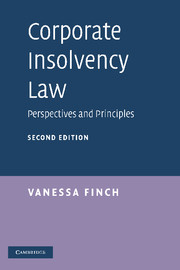Book contents
- Frontmatter
- Contents
- Acknowledgements
- Table of cases
- Table of statutes and other instruments
- List of abbreviations
- Introduction to the second edition
- PART I Agendas and objectives
- PART II The context of corporate insolvency law: financial and institutional
- 3 Insolvency and corporate borrowing
- 4 Corporate failure
- 5 Insolvency practitioners and turnaround professionals
- PART III The quest for turnaround
- PART IV Gathering and distributing the assets
- PART V The impact of corporate insolvency
- 18 Conclusion
- Bibliography
- Index
3 - Insolvency and corporate borrowing
Published online by Cambridge University Press: 05 June 2012
- Frontmatter
- Contents
- Acknowledgements
- Table of cases
- Table of statutes and other instruments
- List of abbreviations
- Introduction to the second edition
- PART I Agendas and objectives
- PART II The context of corporate insolvency law: financial and institutional
- 3 Insolvency and corporate borrowing
- 4 Corporate failure
- 5 Insolvency practitioners and turnaround professionals
- PART III The quest for turnaround
- PART IV Gathering and distributing the assets
- PART V The impact of corporate insolvency
- 18 Conclusion
- Bibliography
- Index
Summary
The issues attending corporate insolvency law are closely linked to those surrounding corporate borrowing. It is the creation of credit that gives rise to the debtor–creditor relationship and makes insolvency possible in the first place. Credit can be obtained by companies in a variety of ways, as we will see in this chapter, and the various modes of obtaining debt bring with them different arrangements for dealing with repayments. These arrangements will be relevant when dealing with companies that can no longer repay all their creditors.
To ask whether the legal framework of corporate insolvency law is acceptable demands, accordingly, some examination of the arrangements that the law recognises for obtaining credit in order to raise corporate capital. If corporations or creditors in an insolvency face problems that arise from the multiplicity and complexity of arrangements for obtaining credit and the ensuing difficulty of resolving the respective claims of different types of creditor, the best way to reform insolvency arrangements might well be to rationalise the legal methods available for raising capital and obtaining credit rather than to tinker with the insolvency rules that apply to the various credit devices.
Insolvency arrangements can be assessed with reference to the factors outlined in chapter 2 but the link with credit should always be borne in mind and companies should be seen in both their healthy and their troubled contexts.
- Type
- Chapter
- Information
- Corporate Insolvency LawPerspectives and Principles, pp. 69 - 143Publisher: Cambridge University PressPrint publication year: 2009
- 4
- Cited by



